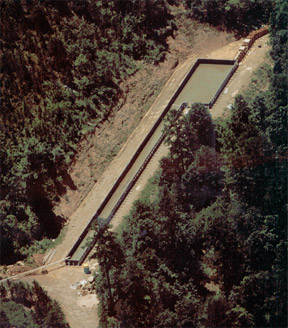Simulating Storm Events
(As Appeared in Environmental Testing & Analysis)

Stream channels with “step-pool” morphology occur in virtually all forested mountain landscapes. “Step-pool” refers to the alternating sequence of steep and flat sections that give them a stair-like structure longitudinally. These channels often occur within or immediately downstream of timber harvesting areas.
Despite their environmental and geomorphic importance, little is known about how these channels function and maintain their form. The physical structure and transport processes within step-pool channels are assumed to be controlled by high-flow events, but the specific relationships are unknown. These relationships have been difficult to isolate and measure with precision in mountainous locations for a variety of reasons. The occurrence of high flows during natural storm periods is difficult to predict in advance. Moreover, statistical replication is rarely possible using naturally produced flows. Limited budgets and environmental constraints generally preclude extensive modification of remote research sites. Recreation of mountain stream conditions in laboratory flumes is largely impractical due to the highly variable physical structure of step-pool channels.
A research project recently was undertaken at a remote site on the Ouachita National Forest in Arkansas to develop knowledge and practices that better protect mountain stream environments. To overcome the problems outlines above, our research used a system consisting of an unusual tank, pipelines, flume, and extensive in-channel monitoring instruments to simulate peak flow events within a natural stream environment. The artificial system enabled a research study of stream flow and sediment transport processes that may apply to similar stream types around the world.
Replicating High Flows
Developing an “experimental laboratory” without being unduly invasive to the immediate forest area was a large challenge. Fortunately, a site was located in the Ouchita National Forest where an old logging road occurred near both a representative mountain stream and a flood-control reservoir. This situation allowed for water to be pumped from the reservoir to an impoundment of the old road. Water then was released into the “study reach” within adjacent stream channel where stream flow, sediment transport, and channel characteristics were closely monitored. Immediately downstream of the study reach, the released water joined a large river system whose size was sufficient to prevent adverse response from the additional flow.
The type of impoundment to use was a crucial decision. Early considerations of a pond with an earthen dike were rejected as involving major excavation, high cost and excessive maintenance. Costly round steel or rectangular tanks of fixed dimensions would have been impractical. To minimize site disturbance, an L-shaped impoundment was needed. To avoid environmental and maintenance problems, we wanted something that could be erected and disassembled easily. While multiple rectangular tanks placed side by side could simulate an L shape, a single tank of that configuration was essential to achieve the water output control needed and minimize tank design complexity.
A low-cost modular containment system was rented for use in the study. With relatively simple customization, a 133,400-gallon, L-shaped tank with PVC liner and geotextile underlayment was assembled on site using hand tools. The tank was erected on the old logging road after minimal excavation, leveling, and compaction of the site. The modular design allowed maximum use of the available impoundment area. Use of prefabricated tank materials minimized both costs and shipping time to the site.
High flow events were created through the controlled release of water from the tank via a slide gate and wooden flume into the study reach. The tank was filled and its capacity supplemented during each experimental run by pumping reservoir water through three 1,400-foot aluminum pipelines. The stream flow simulation system allowed us to control the timing and magnitude of the flows created, to replicate given flow conditions to establish variance parameters, and to schedule our experiments when personnel were readily available and costs were minimized.
Findings from this research will help to predict the effects of natural storm events on the physical characteristics and aquatic life of small mountain channels. Such information is vital to understanding how proposed upstream timber harvesting, road construction and other disturbances might affect these channels and downstream areas. Results from this initial and succeeding research studies should lead to knowledge and practices that better protect mountain stream environments.
We hope to conduct follow-up research using this stream-flow simulation system to build upon what we will learn from our initial project. We anticipate that our experimental, process-based approach will help to expand understandings of mountain stream behavior in all areas where such streams occur. Although the field work for our initial study was completed in only five days- following months of planning and preparation- we are confident that the methods and technology we used are viable, cost effective, and useful in conduction this type of research.
